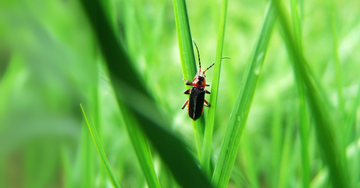In your battle against bugs and other backyard pests, your most potent weapon isn’t a bottle of pesticides — it’s a plan of action to support and improve your lawn’s long-term health. A comprehensive lawn maintenance routine is the best way to discourage insect intruders while also creating vibrant, inviting outdoor spaces.
Here are five expert tips to help your lawn stay strong, healthy, and pest-free all summer long.
Start with enriched soil
Soil quality is the foundation of strong grass and a pest-resistant yard. Using high-grade soil mixed with a blend of rich compost establishes a base layer of vital nutrients and beneficial microbial activity that fosters consistent thick growth and strong blades ready to withstand attacks from insects.
Consider conducting a soil test to assess the makeup of your yard’s soil. This will give you the data you need to amend and improve it with compost, organic matter, or other fertilizer formulas to create the perfect environment for your variety of grass.
Strengthen it with sod and seeding
A thick, lush lawn doesn’t just feel great under your bare feet — it creates an inhospitable ecosystem for invasive insects. A dense carpet of grass means thick root systems and the depletion of nutrients available in the soil, making the area much more difficult and less attractive for pests trying to establish themselves.
Whether you’re laying down sod, hydroseeding, or spreading grass seeds, prioritize high-quality varieties that thrive in your ecosystem. Also, make it a habit to seed your yard regularly to fill in thin or bare patches.
Nourish it with fertilizer
Think of fertilizer as your lawn’s multivitamin, providing the nutrients and minerals essential to robust growth, health, and resilience. By feeding your yard appropriately and regularly, you’re giving it the fuel to continue its growth all season, resulting in constant and consistent crowding out of available space for pests throughout the summer and into the fall.
When picking a fertilizer, make sure to choose one suited to both your variety of grass as well as the season. Slow-release, nitrogen-based fertilizers provide optimal summer time coverage that’s resistant to loss from watering and heat. Be sure to follow the feeding schedule and application instructions on the label.
Build in natural barriers
In addition to nurturing your lawn from the ground up, it’s wise to fortify its borders against backyard pests. Stone and sand products serve as effective and aesthetically pleasing obstacles for creepy crawlies like ants and earwigs. These materials disrupt their typical pathways and make the environment less hospitable for them. Another pest-repelling decorative feature is mulch, specifically varieties made from cypress or cedar due to the presence of chemicals and oils like thujone that deter many types of bugs.
Consider incorporating these features into your landscape design to create physical barriers that keep insects out and enhance the overall health and beauty of your outdoor space.
Maintain the front line
Proper mowing techniques promote healthy growth, minimize stress on the grass, and discourage weed infestations. By keeping your lawn well-manicured and free of overgrown areas, you're creating an environment that’s less attractive to pests and more conducive to the overall health of your turf.That means taking less off each trim, leaving about 2.5 - 3 inches to help withstand the sun and heat. Instead, mow more frequently. Some people might find this schedule unwieldy and hard to manage during the busy summer months. Enlisting a residential grass mowing service can help.
When it comes to watering, do it regularly, but avoid leaving standing pockets of moisture that could act as breeding grounds for insects. A good way to test whether the soil has enough moisture is to stick a screwdriver straight down into it. If it slides in 6- 8 inches, your yard has enough water. If it doesn’t go in at all, your yard is too dry. And if it slides in beyond 8 inches, reduce your watering for a few days.
A lawn care strategy that combines soil, seeding, sod, fertilization and natural barriers with a regular mowing and watering routine is one of the best defences against pests. As a bonus, when you look out your window, you’ll see a beautiful, inviting backyard.





